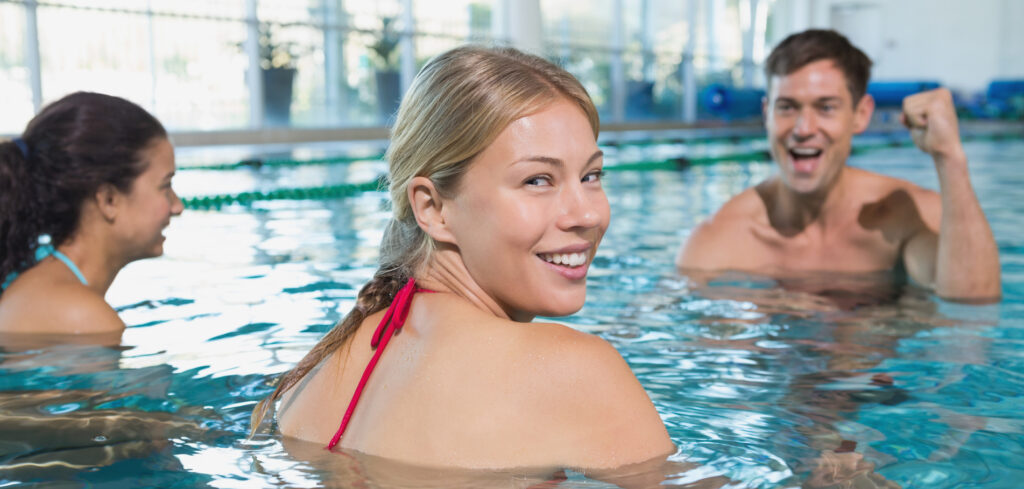Recovering from an injury often requires a careful balance between rest and rehabilitation exercises that strengthen muscles without risking further damage. For many, water workouts offer an ideal solution. The unique properties of water create a supportive environment that can aid in recovery, reduce pain, and promote healing. Here’s why water-based exercises are often recommended as a top choice for injury rehabilitation.
1. Low-Impact Resistance
One of the primary reasons water workouts are effective for recovery is that they offer low-impact resistance. Unlike land-based exercises, water’s buoyancy reduces the stress on joints, tendons, and ligaments, allowing injured areas to be exercised with minimal strain. This is particularly helpful for those recovering from joint injuries or surgeries, as they can begin moving without risking re-injury.
Tip: Start with gentle movements to avoid overworking sensitive areas. Focus on building strength gradually to enhance stability and endurance.
2. Support for Muscle Strengthening
Water resistance provides an excellent opportunity to build muscle strength without the need for heavy weights. In water, every movement requires effort, which helps to engage and strengthen muscles. This resistance helps restore muscle tone and joint stability without placing excessive load on the body, accelerating the recovery process.
Tip: Use water weights or specialized equipment, like aqua dumbbells, to increase resistance and target specific muscle groups in a safe, controlled environment.
3. Reduced Swelling and Inflammation
Cold or even cool water can naturally reduce inflammation and swelling, particularly helpful for injuries involving soft tissues or post-surgical swelling. Hydrotherapy (water therapy) has long been recognized as a way to improve circulation and ease pain, facilitating healing in injured muscles and tissues.
Tip: Consult a therapist about the water temperature that’s best for your specific injury. Cool water is excellent for inflammation, while warm water is often used for relaxation and circulation.
4. Improved Range of Motion
Injuries can lead to stiffness, limited movement, and muscle tightness, often requiring range-of-motion exercises for full recovery. Water supports the body, allowing individuals to move in ways that might be painful or impossible on land. As a result, water exercises can help injured individuals safely improve their flexibility and joint mobility.
Tip: Begin with gentle range-of-motion exercises in water, such as shoulder or hip rotations, and gradually increase the intensity as your flexibility improves.
5. Enhanced Balance and Coordination
Injury recovery often involves reestablishing balance and coordination, especially after extended periods of immobility. Water challenges the body to maintain balance and stability, making it an effective environment for relearning these essential skills. This controlled challenge in the water helps retrain balance and strengthen core muscles, both of which are crucial for full recovery.
Tip: Try exercises like single-leg stands or lateral movements in waist-deep water. The water will support you while providing enough resistance to rebuild coordination and stability.
6. Pain Relief and Relaxation
Water naturally promotes relaxation, helping reduce muscle tension and alleviate pain. The soothing effect of water immersion can reduce discomfort, making it easier for individuals to complete exercises that may otherwise be too painful on land. Many people find water workouts improve their overall mood and reduce the emotional strain that often accompanies injury recovery.
Tip: Incorporate relaxation techniques, such as deep breathing or slow movements, to maximize the therapeutic effects of water and minimize stress.
7. Gentle Cardiovascular Conditioning
Injury recovery can make traditional cardio exercises challenging, as they often put strain on the injured area. Water-based cardio exercises, however, allow for safe cardiovascular conditioning, promoting circulation, boosting metabolism, and supporting overall physical health. This helps maintain fitness levels during recovery, making the transition back to full activity smoother.
Tip: Try gentle aqua jogging or water walking for a cardiovascular workout that doesn’t stress injured areas. These exercises help maintain heart health without compromising recovery.
8. Increased Confidence and Motivation
Recovering from an injury can be mentally challenging, especially if fear of re-injury is present. Water workouts provide a safe, supportive environment that minimizes the fear of falling or straining the injured area, allowing participants to feel more confident as they progress. This boost in confidence can motivate individuals to stay consistent with their rehabilitation program.
Tip: Celebrate small milestones in your water workout routine. This positive reinforcement will help maintain your motivation as you work toward full recovery.
Conclusion
Water workouts offer a safe, effective, and therapeutic way to support injury recovery. From reducing pain and inflammation to enhancing mobility and strength, water-based exercises cater to the unique needs of individuals recovering from injury. If you’re navigating a recovery journey, consider adding water workouts to your routine for a balanced, low-impact approach that promotes both physical and mental healing.





